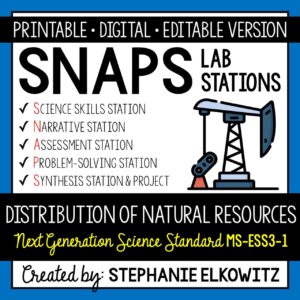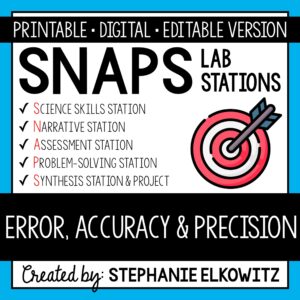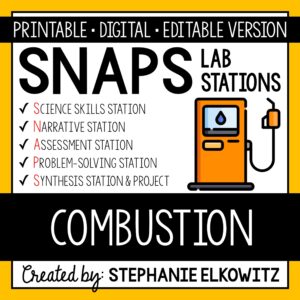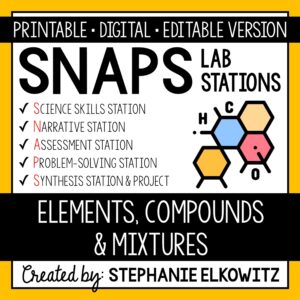Immune Response Lab
$7.00
An engaging lab activity designed to enhance students’ understanding of passive and active immunity, inflammation and humoral and cell-mediated immune responses.
Description
SNAPs Lab Stations Activities require students to use science, math, literacy, problem-solving and engineering skills. They are designed to enhance students’ understanding of scientific concepts and help students apply scientific ideas to the real world. Each station activity promotes skills so to develop students into proficient and competent scientific thinkers.
SNAPs lab activities have five components:
• Science Skills Station to develop science skill proficiency
• Narrative Station to build science literacy
• Assessment Station to evaluate learning and understanding
• Problem-Solving Station to foster engineering design
• Synthesis Station and Project to inspire higher-order learning
DIGITAL LABORATORY – DISTANCE LEARNING & DIGITAL CLASSROOMS
• This lab is offered in a digital format to support digital classrooms & distance learning.
• The digital lab activity is designed to work with Google Slides and Microsoft PowerPoint
• The digital lab activity CANNOT be edited. However:
– Students can manipulate text boxes
– Students can create tables, graphs and diagrams
– Students can insert images and drawings
GOOGLE FORM ASSESSMENT STATION
• The assessment station is offered as a self-grading Google Form.
• Questions are all short answer and are 100% editable.
• Suggestions for use are included in the download.
DISTANCE LEARNING COMPATIBILITY
SNAPs lab activities are rated for their ease with distance – independent learning. Refer to the preview for more information about how well this laboratory works in a fully digital classroom and with distance learning.
EDITABLE DOCUMENTS
This download includes an editable word document (docx file) of all lab components:
• Pre-Lab and Post-Lab Activities
• The Lab Overview
• Lab Station Activities and Questions
• Directed Synthesis Project (when applicable)
Important Notes:
• Diagrams, illustrations, tables and graphs essential to lab activities are included
• Illustrative clipart is NOT included
• Editable documents and rubrics are included with the FREE SNAPs Setup Guide
Editable files allow you to:
• Edit the scope of the activities so to suit your students’ needs
• Edit the materials required based on resource availability
• Create single-period “mini-labs” using activities at the individual skills stations
The activities at each station in this lab are detailed below.
Immune Response Lab Stations Activity Learning Objectives
1. Compare and contrast passive and active immunity.
2. Identify the three lines of defense that protect the body from disease-causing agents.
3. Compare and contrast nonspecific (innate) and specific (adaptive) immunity.
4. Identify nonspecific barriers that keep pathogens out of the body.
5. Explain what occurs during the inflammatory response.
6. Compare and contrast humoral and cell-mediated immunity.
7. Use computer simulations to study and model immune system responses.
8. Evaluate the impact of vaccines in manipulating adaptive immunity against pathogens.
Science Skills Station
Students will use an online interactive module to study the immune system response. Students will study both the innate (nonspecific) and adaptive (specific) responses and what happens with repeat infections. Students will watch a simulation to better understand what occurs with adaptive immunity (humoral and cell-mediated immunity). Students will create a timeline to understand how these responses work relative to each other.
Narrative Station
Students will study the three lines of defense, passive and active immunity, natural and artificial immunity, the three lines of defense and innate and adaptive immunity.
Assessment Station
Students will answer questions about key terms and ideas relating to immunity and immune responses. Students must employ lower, mid and higher order thinking skills to answer these questions.
Problem-Solving Station
Students will study and evaluate vaccines at this station. Students will watch videos to learn about the different types of vaccines and how they work. Students will analyze data so to evaluate the impact of vaccination on specific pathogens. Students will use a computer model to evaluate factors that affect a vaccine’s impact on infection and death rates.
Synthesis Station
Students will compose a CER (claim-evidence-reasoning) report to summarize the lab. Students are provided the claim statement and must support the claim with observations, data and other information gathered in the lab. Students will explain how the evidence supports the claim using scientific reasoning.
Synthesis Project
Students will have a choice of 11 projects. Refer to the SNAPs Lab Stations Best Practices and Setup Guide for directions and suggestions on how to conduct the project.
This download includes:
• A pre-lab assignment and post-lab reflection
• Directions and questions for each lab station
• Student recording sheets
• Teacher Key
Additional Materials Required:
3 Computers or tablets
Colored pencils
LINKS TO VIDEOS
This laboratory requires internet to access videos. Videos are hosted on SafeShare.TV so to safely watch and share educational YouTube videos without ads, comments and other distractions. Shortened and full link(s) to SafeShare.TV included. Full link to original YouTube video(s) included.
NEXT GENERATION SCIENCE STANDARDS
This laboratory does not address a specific Next Generation Science Standard, but it complements NGSS concepts. It combines the three dimensions of science learning – science and engineering practices, disciplinary core ideas and crosscutting concepts – in order to meet the standard. This laboratory also makes interdisciplinary connections to STEM, Math CCSS and ELA CCSS to build the appropriate skills.
TERMS OF USE
• All rights reserved by Stephanie Elkowitz.
• This product is to be used by the original purchaser only.
• Intended for classroom and personal use only.
• Copying for more than one teacher, classroom, department, school, or school system is prohibited.
• This product may not be distributed or displayed digitally for public view.
• Failure to comply is a copyright infringement and a violation of the Digital Millennium Copyright Act (DMCA).








